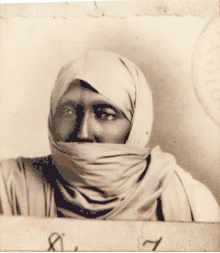Osman Yusuf Kenadid
Osman Yusuf Kenadid (Somali: Cusmaan Yuusuf Keenadiid; Arabic: عثمان يوسف كينايديض), was a Somali poet, writer, teacher and ruler. He created the Osmanya alphabet for writing Somali.
Osman Yusuf Kenadid Cusmaan yuusuf keenadiid | |
|---|---|
 | |
| Born | |
| Occupation | Poet, writer, teacher, ruler |
Biography
Kenadid grew up in the town of Galkayo, situated in north-central present-day Somalia. He served as a leader in the Majeerteen Sultanate of Hobyo and was the son of the polity's founder, Sultan Yusuf Ali Kenadid.
Also a writer, Kenadid published many works on various subjects related to Somali history and science, including textbooks on the Somali language, astronomy, geography and Somali philosophy. He borrowed significantly from the vast ancient Somali cultural repository, working towards a renaissance of this rich past.[1]
In the early 1920s, in response to a national campaign to settle on a standard orthography for the Somali language (which had long lost its ancient script), Kenadid devised a phonetically sophisticated alphabet called Osmanya for representing the sounds of Somali.[1]
Kenadid's Osmanya was subsequently introduced into the local schools in his Sultanate. When the Italian colonial authorities got wind of this, they promptly imprisoned him in Mogadishu since they feared that the script was a manifestation of nationalism.[2] With Kenadid's arrest, all efforts to develop a standard orthography for the Somali language abruptly came to a halt for the next 25 years.[3]
The rise of nationalist sentiment that followed the end of the Second World War – and especially the birth of the Somali Youth League political party, of which Kenadid was a founding member – brought about a revival of interest in and use of the Osmanya script.[3] This renaissance would last until the government of then President of Somalia Mohamed Siad Barre unilaterally elected in 1972 to make the modified Latin script devised by Shire Jama Ahmed the nation's official writing system.[4]
See also
- Osmanya alphabet
- Borama alphabet
- Kaddare alphabet
- Wadaad's writing
- Sheikh Abdurahman Sheikh Nuur
- Hussein Sheikh Ahmed Kaddare
- Musa Haji Ismail Galal
Notes
- Wasaaradda Warfaafinta iyo Hanuuninta Dadweynaha (1974). The Writing of the Somali Language. Ministry of Information and National Guidance. p. 5.
- Irving Kaplan, Area handbook for Somalia, (U.S. Govt. Print. Off.: 1969), p.73
- Institute of African/American Relations (U.S.), Africa special report: bulletin of the Institute of African/American Relations, Volumes 8–9, (The Institute: 1963), p.17
- Mohamed Diriye Abdullahi, Culture and Customs of Somalia, (Greenwood Press: 2001), p.73
References
- Kaplan, Irving, Area Handbook for Somalia, (University of Virginia: 1977)
- Lewis, I.M., Saints and Somalis: Popular Islam in a Clan-based Society, (Red Sea Press: 1998))
External links
- Osmanya, Borama, Wadaad's writing and the Somali language
- Afkeenna iyo fartiisa – a book in Osmanya
- Somali Native Alphabet
- The Gadabuursi Somali Script – qasidas in Gadabuursi/Borama
- Unicode assignments for Osmanya characters
- Osmanya Unicode Fonts